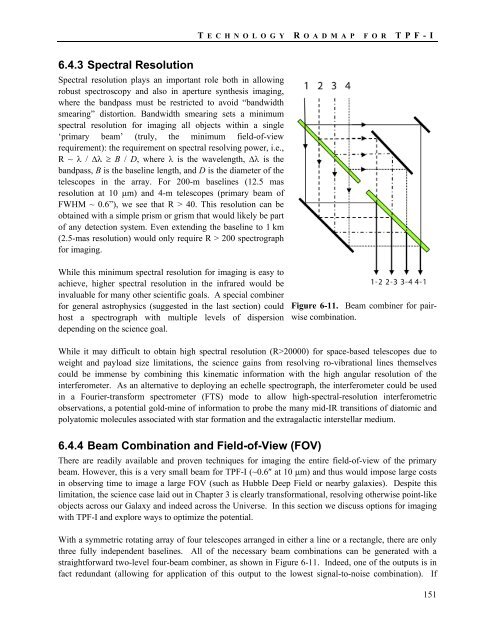TPF-I SWG Report - Exoplanet Exploration Program - NASA
TPF-I SWG Report - Exoplanet Exploration Program - NASA
TPF-I SWG Report - Exoplanet Exploration Program - NASA
Create successful ePaper yourself
Turn your PDF publications into a flip-book with our unique Google optimized e-Paper software.
T E C H N O L O G Y R OADMAP FOR <strong>TPF</strong>-I<br />
6.4.3 Spectral Resolution<br />
Spectral resolution plays an important role both in allowing<br />
robust spectroscopy and also in aperture synthesis imaging,<br />
where the bandpass must be restricted to avoid “bandwidth<br />
smearing” distortion. Bandwidth smearing sets a minimum<br />
spectral resolution for imaging all objects within a single<br />
‘primary beam’ (truly, the minimum field-of-view<br />
requirement): the requirement on spectral resolving power, i.e.,<br />
R ~ λ / Δλ ≥ B / D, where λ is the wavelength, Δλ is the<br />
bandpass, B is the baseline length, and D is the diameter of the<br />
telescopes in the array. For 200-m baselines (12.5 mas<br />
resolution at 10 μm) and 4-m telescopes (primary beam of<br />
FWHM ~ 0.6”), we see that R > 40. This resolution can be<br />
obtained with a simple prism or grism that would likely be part<br />
of any detection system. Even extending the baseline to 1 km<br />
(2.5-mas resolution) would only require R > 200 spectrograph<br />
for imaging.<br />
While this minimum spectral resolution for imaging is easy to<br />
achieve, higher spectral resolution in the infrared would be<br />
invaluable for many other scientific goals. A special combiner<br />
for general astrophysics (suggested in the last section) could<br />
host a spectrograph with multiple levels of dispersion<br />
depending on the science goal.<br />
Figure 6-11. Beam combiner for pairwise<br />
combination.<br />
While it may difficult to obtain high spectral resolution (R>20000) for space-based telescopes due to<br />
weight and payload size limitations, the science gains from resolving ro-vibrational lines themselves<br />
could be immense by combining this kinematic information with the high angular resolution of the<br />
interferometer. As an alternative to deploying an echelle spectrograph, the interferometer could be used<br />
in a Fourier-transform spectrometer (FTS) mode to allow high-spectral-resolution interferometric<br />
observations, a potential gold-mine of information to probe the many mid-IR transitions of diatomic and<br />
polyatomic molecules associated with star formation and the extragalactic interstellar medium.<br />
6.4.4 Beam Combination and Field-of-View (FOV)<br />
There are readily available and proven techniques for imaging the entire field-of-view of the primary<br />
beam. However, this is a very small beam for <strong>TPF</strong>-I (~0.6″ at 10 μm) and thus would impose large costs<br />
in observing time to image a large FOV (such as Hubble Deep Field or nearby galaxies). Despite this<br />
limitation, the science case laid out in Chapter 3 is clearly transformational, resolving otherwise point-like<br />
objects across our Galaxy and indeed across the Universe. In this section we discuss options for imaging<br />
with <strong>TPF</strong>-I and explore ways to optimize the potential.<br />
With a symmetric rotating array of four telescopes arranged in either a line or a rectangle, there are only<br />
three fully independent baselines. All of the necessary beam combinations can be generated with a<br />
straightforward two-level four-beam combiner, as shown in Figure 6-11. Indeed, one of the outputs is in<br />
fact redundant (allowing for application of this output to the lowest signal-to-noise combination). If<br />
151
















